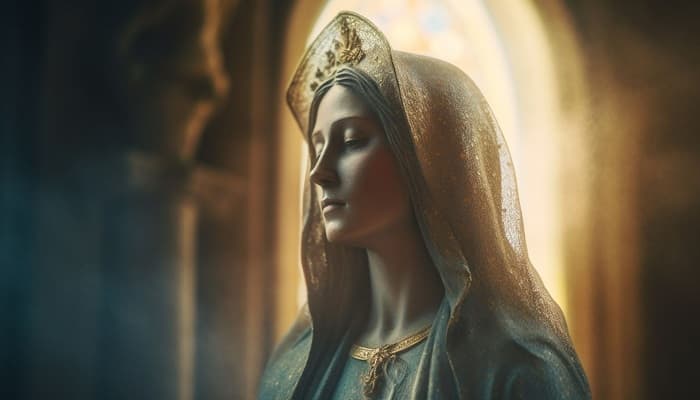Who Is the Virgin Mary in the Bible?
The Virgin Mary, also known as Mary, the mother of Jesus, is one of the most recognized women in Scripture. Described as “highly favored” by God (Luke 1:28, NKJV), Mary received extraordinary grace, not because she was divine or perfect, but because God chose her to carry out a sacred mission: to give birth to the Messiah.
The term “highly favored” comes from a Greek word meaning “much grace.” Like every other person, Mary needed God’s grace and a Savior. She acknowledged this herself when she declared, “My spirit has rejoiced in God my Savior” (Luke 1:47, NKJV). This confession shows that Mary, though chosen and blessed, was still a human being in need of salvation.
Throughout the Bible, Mary is portrayed as a humble, obedient, and faithful servant of the Lord. She asked the angel Gabriel, “How can this be, since I do not know a man?” (Luke 1:34), and when told that the Holy Spirit would overshadow her, she responded with trust: “Let it be to me according to your word” (Luke 1:38, NKJV). Her response is one of remarkable faith and surrender.
Was Mary Without Sin?
Despite her unique role in salvation history, Mary was not without sin. Scripture clearly teaches that “there is not a just man on earth who does good and does not sin” (Ecclesiastes 7:20, NKJV) and that “all have sinned and fall short of the glory of God” (Romans 3:23, NKJV). Nowhere in the Bible is Mary portrayed as sinless or divine.
The idea of an immaculate conception,that Mary herself was born without sin, is not found in Scripture. Likewise, the concept of her perpetual virginity is not supported by the Bible. Matthew 1:25 says Joseph “did not know her till she had brought forth her firstborn Son. And he called His name Jesus” (NKJV).
The word “till” clearly implies that Mary and Joseph had normal marital relations after Jesus' birth. Jesus had siblings: “Is this not the carpenter’s son? Is not His mother called Mary? And His brothers James, Joses, Simon, and Judas? And His sisters, are they not all with us?” (Matthew 13:55–56, NKJV).
Is It Biblical to Pray to Mary?
 In her lifetime, Mary showed spiritual depth. Twice, she is said to have “kept all these things and pondered them in her heart” (Luke 2:19, 2:51, NKJV), demonstrating her reflective nature and devotion to God’s work through her Son. She witnessed Jesus’ first miracle at the wedding in Cana (John 2:1–11), was present at the crucifixion (John 19:25), and remained with the apostles in prayer after the resurrection (Acts 1:14). These moments confirm her faithful walk with God.
In her lifetime, Mary showed spiritual depth. Twice, she is said to have “kept all these things and pondered them in her heart” (Luke 2:19, 2:51, NKJV), demonstrating her reflective nature and devotion to God’s work through her Son. She witnessed Jesus’ first miracle at the wedding in Cana (John 2:1–11), was present at the crucifixion (John 19:25), and remained with the apostles in prayer after the resurrection (Acts 1:14). These moments confirm her faithful walk with God.
Still, when someone in the crowd praised Mary by shouting, “Blessed is the womb that bore You,” Jesus replied, “More than that, blessed are those who hear the word of God and keep it!” (Luke 11:27–28, NKJV). Jesus pointed to obedience to God’s Word as the true measure of blessedness, not biological connection.
While Mary was “blessed among women” (Luke 1:42, NKJV) and certainly deserves honor as the mother of Jesus, the Bible never instructs us to pray to Mary, worship her, or assign her a mediating role. In fact, Scripture is clear: “For there is one God and one Mediator between God and men, the Man Christ Jesus” (1 Timothy 2:5, NKJV).
Get Closer to God Today
4.9
Average Rating
|Over 5 Million Downloads
Do All Christians Believe in the Virgin Mary?
Christians across denominations believe in Mary, the mother of Jesus, but they differ in how they understand her role.
Roman Catholics and Eastern Orthodox Christians hold the Virgin Mary in especially high esteem, often referring to her as the Mother of God and honoring her with titles like Blessed Virgin Mary and Holy Mary. They believe in doctrines such as the Immaculate Conception and Assumption, which are not found in Scripture but stem from tradition.
Protestants, on the other hand, respect Mary as the mother of Jesus but do not venerate or pray to her. They emphasize her humility and faith without assigning her divine status or intercessory powers.
The Bible highlights Mary’s obedience and faith (Luke 1:38), but it also shows that salvation comes through Jesus Christ alone (1 Timothy 2:5). So while all Christians recognize Mary, beliefs about her vary widely across traditions.
Why Is Mary Called the Mother of God?
The title Mother of God refers to Mary, the mother of Jesus, and was formally affirmed at the Council of Ephesus in AD 431. The Church used the Greek term Theotokos (“God-bearer”) to emphasize the unity of Christ’s divine and human natures.
Since Jesus is both fully God and fully man (John 1:14), and Mary gave birth to Him, she is rightly called the Mother of God, not as the originator of His divinity, but as the vessel through whom the eternal Son of God entered the world in human form.
This title protects the doctrine of the Incarnation against heresies like Nestorianism, which wrongly separated Christ’s two natures. However, calling Mary the Mother of God does not mean she is divine or deserves worship. Scripture is clear: Jesus alone is our mediator (1 Timothy 2:5). Mary’s role was honored, but her veneration in some traditions goes beyond what the Bible teaches.
How Old Was Mary When She Had Jesus?
![]() The Bible does not state how old Mary was when she had Jesus, but historical and cultural context gives us a general idea. In first-century Jewish culture, it was common for girls to be betrothed and married as early as age 12 to 14. Based on this, most scholars and historians estimate that the Virgin Mary was likely around 13 to 15 years old when she conceived and gave birth to Jesus.
The Bible does not state how old Mary was when she had Jesus, but historical and cultural context gives us a general idea. In first-century Jewish culture, it was common for girls to be betrothed and married as early as age 12 to 14. Based on this, most scholars and historians estimate that the Virgin Mary was likely around 13 to 15 years old when she conceived and gave birth to Jesus.
In Luke 1:27–38 (NKJV), we read about Mary, a virgin, being visited by the angel Gabriel and told she would conceive the Son of God by the power of the Holy Spirit. Despite her young age, Mary the mother of Jesus showed great faith and submission to God’s will, saying, “Let it be to me according to your word” (Luke 1:38).
While this estimate may seem startling today, it reflected the norms of the time. What stands out is not Mary’s age, but her deep trust and obedience to God. The Bible portrays her as a humble servant, chosen for a unique and sacred purpose.
Get Closer to God Today
4.9
Average Rating
|Over 5 Million Downloads
What Happened to Mary After Jesus Died?
After Jesus’ death, the Virgin Mary remained a faithful believer and follower of her Son. The Bible tells us she was present at the crucifixion, where Jesus, in His final moments, entrusted her care to the apostle John (John 19:25–27, NKJV). This suggests that Mary mother of Jesus lived with John afterward, possibly in Jerusalem or Ephesus, though Scripture does not confirm where.
The last direct biblical mention of Mary occurs in Acts 1:14, where she is seen praying with the disciples in the upper room after Jesus’ ascension. She was likely among the 120 believers who received the Holy Spirit at Pentecost (Acts 2:1–4). After this, the Bible is silent about what happened to Mary after Jesus died.
Church tradition suggests she lived out her life under John's care and died as a faithful follower of Christ. However, unlike later legends that claim Mary was assumed into heaven, the Bible does not record any supernatural event concerning her death.
Like all believers, Mary needed salvation through faith in Jesus (Acts 4:12; Romans 3:23). Though she played a unique role in history, she is honored for her faith, not for divinity, and is now in heaven by grace, like all who believe.
What Did Mary Look Like?
The Bible does not give a physical description of Mary, the mother of Jesus. Nowhere in the New Testament does it mention her height, hair color, eye color, or clothing style in detail. This silence suggests that Scripture’s focus is on Mary’s faith and character, not her appearance. What we do know comes from understanding her background.
Mary was a young Jewish woman from Nazareth in Galilee (Luke 1:26–27, NKJV). Based on historical and cultural context, she likely had the typical features of a first-century Jewish girl: olive-toned skin, dark eyes, and dark hair. She probably wore modest clothing, including long garments and a head covering, consistent with the customs of her time and faith.
The emphasis in Scripture is not on what Mary looked like, but on who she was in God’s eyes. The angel Gabriel greeted her with, “Rejoice, highly favored one, the Lord is with you; blessed are you among women!” (Luke 1:28, NKJV). Her humility, obedience, and faith are what set her apart. In her own words, she said, “My soul magnifies the Lord, and my spirit has rejoiced in God my Savior” (Luke 1:46–47, NKJV).
Mary’s inner beauty, her willingness to surrender to God’s plan, is what Scripture highlights. Her story reminds us that God values the heart far more than outward appearance (1 Samuel 16:7).
Learn More About the Virgin Mary With Bible Chat
If you’ve ever wondered about Mary mother of Jesus, how she died, how old she was when she had Jesus, or any other Biblical character, the Bible Chat App can help you go deeper with your learning. Whatever you’re curious about, the app offers answers rooted in the Bible and sound theology.
Bible Chat allows you to explore biblical truth with clarity and confidence, even when you’re on the go.
📱 Download the app today from Google Play or the Apple App Store.
Get Closer to God Today
4.9
Average Rating
|Over 5 Million Downloads
Conclusion
While all Christians believe in Mary, the way she is viewed differs across traditions. The Bible presents her as a faithful, humble servant chosen by God to bear His Son, Jesus. She is worthy of respect, but not worship.
Scripture focuses on her faith and obedience, not her status. To know the Virgin Mary rightly is to understand her place in the story of redemption and to give glory to God.
References
- The Holy Bible, New King James Version. (1987). Thomas Nelson.
- What does the Bible say about the virgin Mary?, https://www.gotquestions.org/virgin-Mary.html, accessed on 17.06.2025;
- Is Mary the mother of God (Theotokos)?, https://www.gotquestions.org/Mary-mother-God-theotokos.html, accessed on 17.06.2025;
- What happened to Mary?, https://www.gotquestions.org/what-happened-to-Mary.html, accessed on 17.06.2025.
Image Source: Freepik.com




